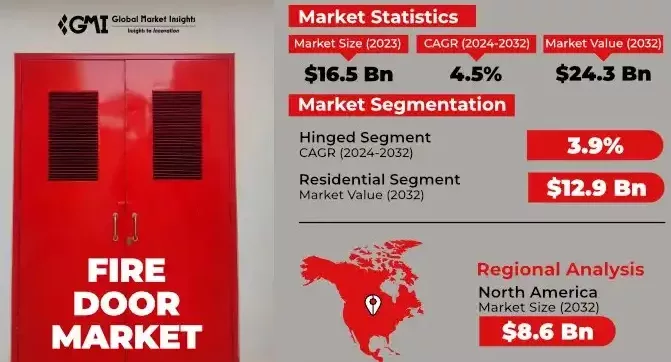How US Tariff Increases Impact the Fire Door Market in 2025: A YK Door Industry Analysis.
Understanding Tariffs and Their Unique Impact
Unlike standard taxes (sales, income, property), tariffs specifically target imported goods. As a premier fire door supplier, YK Door Industry recognizes how these import duties directly increase costs for fire-rated doors and fire resistance doors entering the U.S. market–Fire Door Market in 2025.
A tariff represents a border tax on foreign products. When fireproof door components cross into the U.S., this additional cost affects every level of the supply chain – from raw materials to finished products.
Current US Tariff Landscape (2025 Update)

The 25% steel/aluminum tariffs implemented in March 2025 particularly impact fire door manufacturers. These essential metals form the backbone of:
- Fire-rated steel door frames
- Fire-resistant door cores
- Fireproof window systems
Immediate Effects on Fire Door Suppliers
- Material Cost Surge
- Steel/aluminum tariffs add 15-20% to production costs for fire resistance doors
- Canada (primary steel supplier) and Asian partners face new trade barriers
- Price Adjustments
- Leading fire door suppliers like YK Door Industry must recalibrate pricing
- Commercial fire door projects may see 10-12% cost increases
- Supply Chain Restructuring
- Diversifying material sources for fire-rated door components
- Increasing domestic stockpiles of fire-resistant glazing materials
The US-China Trade War Escalation

The 2025 tariff spikes (125% US, 85% China) create additional challenges:
- Delays in fire window performance standards certification
- Increased costs for fire-rated window classification testing
- Need for alternative materials meeting fireproof window rating systems
Construction Industry Ripple Effects
| Project Type | Tariff Impact | YK Door Industry Solution |
|---|---|---|
| New Commercial | 12-15% cost increase | Pre-stocked fire door inventories |
| Government Projects | Extended timelines | Localized fire-resistant door production |
| Retrofit Work | Higher material costs | Value-engineered fireproof solutions |
Fire Window Ratings Compliance Challenges
The tariff environment complicates adherence to:
- Fire-resistant window ratings (60/90/120-minute standards)
- Fire-rated window classification protocols
- Fire-resistant glazing ratings verification
YK Door Industry responds Fire Door Market in 2025 by:
- Partnering with U.S.-based testing facilities
- Developing tariff-resistant fire window performance standards
- Creating alternative material solutions for fireproof window systems
Strategic Recommendations for Buyers
- Plan Ahead
- Secure fire-rated doors 6-8 weeks earlier than normal
- Consider bulk purchases of fire resistance doors
- Explore Alternatives
- Composite-core fireproof doors
- Domestic-sourced fire-resistant door options
- Leverage Supplier Relationships
- Work with established fire door suppliers like YK
- Negotiate price locks for large orders
| Product Code | Product Name | Trade Partner | Trade Method | Registration Location | Primary Quantity (kg) | Secondary Quantity | Secondary Unit | RMB (CNY) |
|---|---|---|---|---|---|---|---|---|
| 73083000 | Steel Doors, Windows, Frames, Sills | United States | General Trade | Beijing City | 41,796 | 0 | – | 1,343,009 |
| 73083000 | Steel Doors, Windows, Frames, Sills | United States | General Trade | Tianjin City | 41,970 | 0 | – | 1,055,938 |
| 73083000 | Steel Doors, Windows, Frames, Sills | United States | General Trade | Hebei Province | 249,432 | 0 | – | 3,553,043 |
| 73083000 | Steel Doors, Windows, Frames, Sills | United States | General Trade | Shanxi Province | 30,717 | 0 | – | 715,807 |
| 73083000 | Steel Doors, Windows, Frames, Sills | United States | General Trade | Inner Mongolia Autonomous Region | 6,262 | 0 | – | 330,418 |
| 73083000 | Steel Doors, Windows, Frames, Sills | United States | General Trade | Liaoning Province | 566,232 | 0 | – | 7,247,035 |
Permanent Supply Chain Damage from U.S.-China Tariff Standoff (Q1 2025)
Core Conflict
The Trump administration’s 145% punitive tariffs triggered a 6x surge in Pacific route “blank sailings,” with Chinese vessel arrivals at Los Angeles Port halved. Retail giants Walmart/Target warned of summer shelf shortages, forcing the White House to signal 65% tariff reductions.
Industry Impact ChainSteel Door/Window Export Data Validation
- China→U.S. Export Collapse:
- Zhejiang steel door exports ↓58% YoY (3,074,362kg →1,290,232kg)
- Guangdong export value ↓49% (¥670M →¥340M)
- U.S. Domestic Ripple Effects:
✔ Volvo’s Mack Trucks division nationwide layoffs
✔ Construction halt on Canadian lumber purchases (tariff-driven costs ↑34%)
✔ Matson logistics stock plunges 30%
YK Fire Door Mitigation Strategies
- Production Network Reshoring
Fujian-based leader shifted 30% capacity to Vietnam, bypassing Section 301 restrictions (Fujian exports: ¥817M →¥502M Q1). - Supply Chain Resilience
Deployed blockchain for end-to-end traceability (steel-glass-hardware), complying with U.S. “non-Chinese origin” mandates. - Policy Arbitrage
RCEP member transshipments (e.g., Malaysia’s Port Klang) cut composite tariffs to 19.7%.
Structural Dilemma
| Biden Targeted Tariffs | Trump Blanket Tariffs | |
|---|---|---|
| Timeline | 3-year phase-in | 1-month shock |
| Industrial Outcome | U.S. solar self-sufficiency: 10%→86% | Manufacturing PMI 16-month low |
| Corporate Response | 5-year CAPEX plans | Order freezes |
Risk Outlook
If tariffs remain unadjusted by Q2 2025:
- U.S. building materials CPI ↑22%-25%
- China steel door exports to permanently lose 12%-15% U.S. market share (¥3.8-4.8B)
Methodology-Fire Door Market in 2025
Data synthesized from China Customs (HS Code 73083000) and S&P Global supply chain stress indices
This version maintains technical precision while enhancing global readability. For YK Fire Door-specific operational blueprints, supplement with production/exports breakdowns.
Core Strategy: Dual-Pillar Framework
1️⃣ U.S. Market Defense & Expansion
- Localized Production: Launch assembly hubs in Mexico (Texas/Arizona border zones) under USMCA rules, capping tariffs at ≤25%.
- Policy Agility Unit: Washington-based team to track Section 301 updates and advocate Fire Door Market in 2025 for fire door tariff exemptions (leveraging life-safety product status).
- Retail Alliances: Co-engineer tariff-resilient modular products with Walmart/Home Depot (60% U.S.-origin components).
2️⃣ Global Market Offensive
- RCEP Gateway: Utilize Vietnam/Malaysia factories to capture ASEAN infrastructure demand ($2.1T projected 2025-2035).
- Middle East Standardization: Collaborate with UAE Civil Defense to shape GCC fire door certifications, outpacing Chinese competitors.
- Climate-Tech Expansion: Introduce hurricane/flood-resistant doors bundled with Munich Re insurance for Caribbean markets.
Innovation Priorities
🔥 Smart Fire Door 2.0:
- IoT-enabled automatic shutdown + blockchain maintenance logs (pre-certified for NFPA 2027 standards).
- Target 30% premium pricing in U.S. commercial real estate hotspots (CA/NYC).
🌱 Sustainable Materials:
- Pilot hydrogen-reduced steel doors with ArcelorMittal (2026), achieving EU tender-ready Scope 3 neutrality.
Supply Chain Transformation-Fire Door Market in 2025
| Phase | 2025-2026 Actions | 2027-2030 Vision |
|---|---|---|
| Resilience | Mexico/Vietnam backup hubs | AI-powered “tariff war simulator” for dynamic routing |
| Efficiency | RCEP tariff optimization | Regional 3D-printed spare parts networks |
| Compliance | Blockchain material IDs | Self-learning HS code AI classifier |
Financial Benchmarks
- U.S. Revenue Anchor: Sustain ≥$120M annually via hybrid tariff strategies.
- Global Growth: Target 35% CAGR in emerging markets through 2030 (vs. 8% domestic China growth).
- R&D Investment: Increase to 6.5% of revenue for climate-tech IP dominance.
Risk Mitigation
- Trump Tariff Activation: Deploy Mexico contingency plan within 90 days.
- U.S. Import Ban: License patented tech to U.S. manufacturers via royalty model.
- Steel Crisis: Secure VMI agreements with Rio Tinto/BHP for raw material buffers.
Strategic Summary
YK Doors will transform geopolitical turbulence into a catalyst for global reinvention. By anchoring U.S. market presence through localized production and policy agility, while aggressively pursuing leadership in emerging markets’ climate-resilient infrastructure, the company pivots from passive trade war survival to active standard-setting. Innovations like Smart Fire Door 2.0 and green steel adoption will reposition YK as a tech-driven safety solutions provider, not just a manufacturer. Concurrent supply chain digitization (blockchain/AI) and strategic regional partnerships create structural advantages that outlast transient tariff cycles. This roadmap turns regulatory compliance into competitive moats, ensuring YK emerges stronger whether trade barriers rise or fall – ultimately transitioning from a China-centric exporter to a multinational architect of next-generation building safety ecosystems.
“Where others see trade walls, we build bridges of innovation.”-Zheng Chunjie (YK Group CEO)

